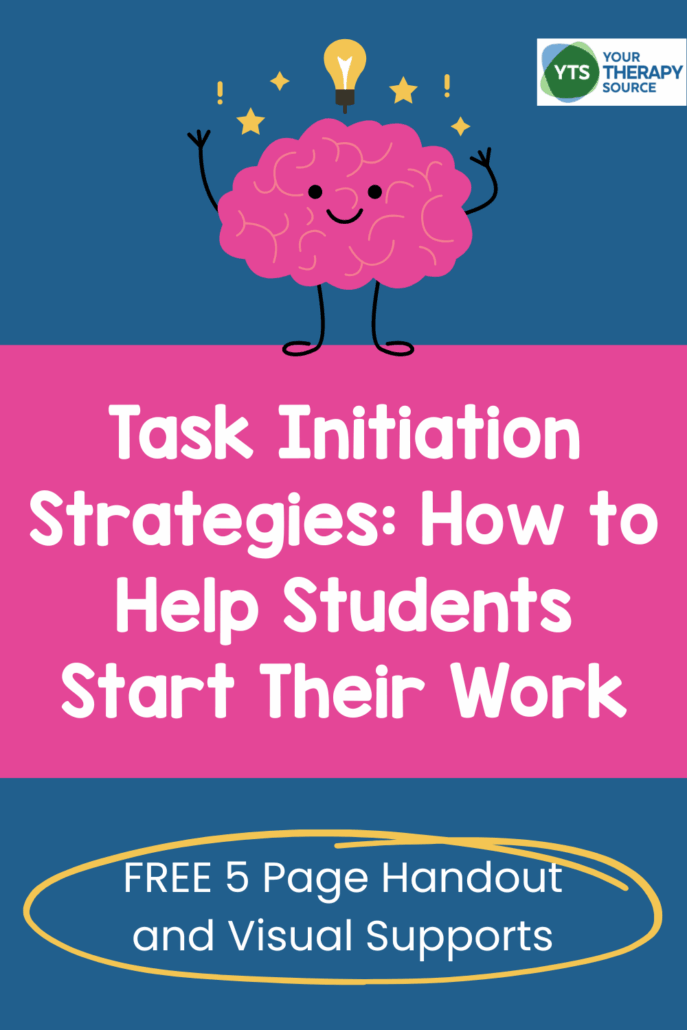Task Initiation Strategies: How to Help Students Start Their Work
When students struggle to begin assignments, the issue is often more than reluctance. It can reflect difficulty with task initiation, an executive function skill that allows learners to start a task efficiently and independently. For some students, beginning work is the hardest part of learning. By understanding the barriers to task initiation and using research-based scaffolding, educators can help students gain confidence and independence in the classroom.
You can download a FREE 5 page handout to help with scaffolding task initiation and simple visual supports at the bottom of the post.

Understanding Task Initiation Challenges
Task initiation requires planning, motivation, and self-regulation. Students who find it difficult to start may not know how to begin, feel unsure of expectations, or fear making mistakes. Others may become overwhelmed by multi-step assignments or lack the internal drive to begin without support.
Common signs of task initiation challenges include:
- Avoidance behaviors such as doodling or talking instead of starting
- Statements like “I don’t know what to do” or “This is too hard”
- Needing constant reminders to begin tasks
- Taking excessive time to get materials ready
- Complete shutdown
According to research by Billingsley (2016), academic expectations often act as antecedents that trigger problem behaviors such as refusal or off-task activity. When tasks feel too difficult or unclear, students may resist starting to avoid failure or frustration. Addressing the root cause with scaffolding can turn avoidance into action.
How Task Initiation Challenges Affect Academic and Social Success
Research by Laursen, Richmond, Kiuru, Lerkkanen, and Poikkeus (2022) examined how early task avoidance behaviors predict later academic and social outcomes. The study followed children from first through third grade and found that students who avoided academic tasks early in school tended to show lower reading and math performance over time.
These academic struggles then led to declining peer acceptance, suggesting that early difficulties with task initiation and engagement can create a cycle of academic and social challenges. The researchers emphasized that identifying and supporting students who show early signs of task avoidance can prevent this downward pattern by strengthening motivation, competence, and peer relationships in the classroom.
Research-Based Scaffolds to Support Task Initiation
Effective supports for task initiation begin before the assignment even starts. These antecedent-based strategies reduce barriers and help students approach learning with confidence.
1. Differentiate the Task
Students are more likely to engage when work matches their ability level. Adjust the complexity, offer shorter sections, or allow alternative ways to show understanding. A quick pre-assessment or review can guide how to modify tasks for readiness.
2. Provide Visual and Verbal Prompts
Visual reminders are powerful for task initiation. Display a Start My Work checklist on the student’s desk:
- I know what to do.
- I have what I need.
- I can start one part at a time.
Pair visuals with short, supportive cues such as:
- “Let’s start with the first question together.”
- “Try one step, and I’ll check in after.”
These gentle prompts reduce anxiety and help students transition from thinking to doing.
3. Offer Guided Practice
Model how to start the task. Use “I do, we do, you do” to gradually release responsibility. Provide opportunities to begin short, success-oriented assignments before expecting independent starts.
4. Reinforce Effort, Not Speed
Praise students for getting started, not just finishing. Statements like, “You got started right away—that’s great progress,” encourage momentum. A small sticker, token, or “Start Strong” chart can serve as motivation for consistent initiation.
5. Build Predictable Routines
A structured start to class helps students know what to expect. Use consistent cues such as a timer, bell, or verbal signal to indicate it’s time to begin work. Predictability reduces hesitation and fosters self-initiation over time.

Guiding Growth: Scaffolding Functional School Skills
Task Initiation Scaffolding Plan for Students
You can download the FREE complete task initiation scaffolding plan for students at the bottom of this post.
Objective
To help students independently begin assigned tasks with confidence and persistence, using available supports and strategies when needed.
Strategies
- Display the “Start My Work” checklist visually.
- Provide a “First–Then” card (First start my work, Then take a break).
- Model the first step together and fade support gradually.
- Break the assignment into smaller parts with visual progress indicators.
- Offer choices in materials or task order to build autonomy.
- Reinforce successful starts with praise or a tangible reward.
- Keep a calm, organized, and consistent environment.
Progression Goals
- Begin a task after verbal or visual prompting with adult support.
- Start tasks independently within two minutes using cues.
- Consistently initiate work independently without prompts.
Promoting Independence Through Task Initiation
Supporting task initiation is not about forcing compliance. It’s about teaching a skill. When educators provide clear structure, gentle cues, and consistent reinforcement, students learn that starting is safe and achievable. Early success builds confidence, and confidence leads to independence. With patience and practice, students can develop the self-regulation and motivation needed to begin any task on their own.
References
Billingsley, G. M. (2016). Combating work refusal using research-based practices. Intervention in School and Clinic, 52(1), 12–16. https://doi.org/10.1177/1053451216630289
Laursen, B., Richmond, A., Kiuru, N., Lerkkanen, M.-K., & Poikkeus, A.-M. (2022). Off on the wrong foot: Task avoidance at the outset of primary school anticipates academic difficulties and declining peer acceptance. European Journal of Developmental Psychology, 19(4), 601–615. https://doi.org/10.1080/17405629.2021.1936491
DOWNLOAD YOUR FREE SCAFFOLDING HANDOUT AND SIMPLE VISUAL SUPPORTS FOR TASK INITIATION HERE
Enter your email to access the handout.



